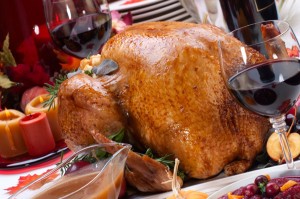 Thanksgiving is a special celebration where our relatives and friends gather around the table to eat abundantly and celebrate, not unlike a Roman feast, but (usually) much more civilized. The average amount of calories consumed on this day usually ranges between 3,000 and up to 4,500, more than two days’ worth for most of us(1). It is not uncommon to see popped seams and shirt buttons on the floor when the pie is finally served. “Eat, drink, and be merry” is the mot de jour on this holiday, and ‘moderation’ is temporarily removed from the English language.
Thanksgiving is a special celebration where our relatives and friends gather around the table to eat abundantly and celebrate, not unlike a Roman feast, but (usually) much more civilized. The average amount of calories consumed on this day usually ranges between 3,000 and up to 4,500, more than two days’ worth for most of us(1). It is not uncommon to see popped seams and shirt buttons on the floor when the pie is finally served. “Eat, drink, and be merry” is the mot de jour on this holiday, and ‘moderation’ is temporarily removed from the English language.
We’ve all heard of that common myth that eating more while you drink will “soak up” the alcohol in your stomach and prevent you from getting too drunk, an ancient myth that may have its roots in college parties. However, that second (or third, or fourth) plate of turkey and stuffing won’t stop your body from processing that second (or third, or fourth) glass of wine. Your digestive system works much like an older computer. Everything you input into the system will just be added to already long queue, and just take longer to process.
The human body generally digests one drink per hour(2). While you are enjoying some pre-dinner conversation and a pre-dinner cocktail to facilitate said conversation, the alcohol in your drink will be absorbed into your bloodstream at a normal rate. This is because the rate of absorption is higher than the rate that the alcohol is eliminated from your system, especially on an empty stomach with nothing to slow down the process. Think of this as a cup with a small drip at the bottom being filled more rapidly than it empties.
Researchers Borkenstein, Jones, and Neri conducted a 2006 study on consistent alcohol consumption, which produced the following results. In the experiment, twelve men were asked to drink over a period of 5-10 hours. Blood samples from the men were collected periodically to measure rates of absorption over the time period. Results showed that consistent heavy drinking over an extended period did not speed up absorption but rather it steadily climbed; the time it took to reach maximum intoxication usually exceeded by the time spent drinking, although by only a small margin. The drop-off rate, or rate of elimination, took much longer. Essentially, what this means is that ingested alcohol is absorbed by the body at a constant rate, and generally, also eliminated at a constant rate.
Adding food to this equation, especially in Thanksgiving-level proportions, slows down the rate which alcohol is absorbed by giving another “task” to the digestive system. We begin digesting carbohydrates through saliva, but protein and fats aren’t processed until they reach the intestines. A fat and protein- heavy Thanksgiving meal generally takes many hours to digest, so ingested alcohol can also stay in the system for long periods of time because of an overloaded digestive system. So while you may not reach peak levels of intoxication as you would without food, drinks will still stay in your system longer, BAC will still climb, and the alcohol take longer to be eliminated. While we may refill our wine glasses in anticipation of a family discussion on politics or in an attempt to delay the inevitable clean up, the alcohol’s effects will be delayed by turkey and stuffing but stay in the system longer than usual.
So be careful tomorrow, and on Thanksgivings to come, of how much food (and drink) you take. A heavy meal will keep drinks in the body much longer than usual, so they may still be in your system when you leave the party to drive home. An unwelcome post-Thanksgiving hangover could make us stop drinking cold turkey, at least until the next family gathering at Christmastime.
(1) http://www.acefitness.org/
Jones, A.W., Wigmore, J.G., & House, C.J. (2006). The Course of the Blood-Alcohol Curve After Consumption of Large Amounts of Alcohol under Realistic Conditions. The Canadian Society of Forensic Sciences Journal, 39




